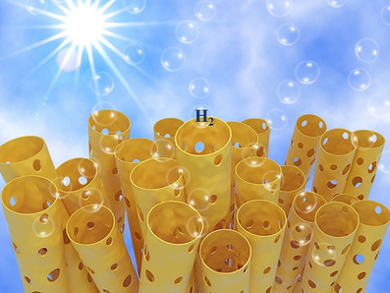Graphitic carbon nitride (g-CN) is considered a very promising photocatalyst for hydrogen generation. This is due to its unique electronic band structure, good chemical stability, eco-friendliness, and reasonable cost. However, it usually has a low surface area. For further improving the catalytic activity, multilevel and hierarchical nanostructuring of g‐CN is highly desirable to effectively expose active sites and facilitate separation and migration of photoexciteded charge carriers.
Qing Han, Liangti Qu, and colleagues, Beijing Institute of Technology, China, have prepared wall-mesoporous graphitic carbon nitride nanotubes (g-CNNTs, pictured) which can be used as photocatalysts. The synthesis involved the annealing of urea microrod arrays, which were formed using a vertical gradient freeze growth (VGFG) method.
The hierarchical g-CNNTs have a high photocatalytic H2 production rate of 8789 μmol h–1 g–1, with an excellent apparent quantum yield of 6.3 % under visible light irradiation. The material provides long-term cycling stability and outperforms previously reported g-CN tubes and most nanostructured g-CN photocatalysts.
The team attributes the high photocatalytic activity to the mesoporous surface nanotube structure of g-CNNTs, which provides many bonding sites and ensures a sufficient contact area between the catalyst and the reactants, and to the 1D structure that is favorable for the transport of photogenerated electrons, which, in turn, inhibits charge recombination.
- Wall-Mesoporous Graphitic Carbon Nitride Nanotubes for Efficient Photocatalytic Hydrogen Evolution,
Qing Han, Jiaxin Bai, Zhihua Cheng, Liangti Qu,
Chem. Asian J. 2018.
https://doi.org/10.1002/asia.201801209


